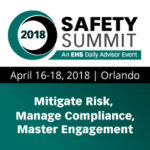Category: Special Topics in Safety Management
Safety is a process, and as such, needs to be managed. This section offers resources to create a viable safety program, sell it to senior management, train supervisors and employees in using it, and then track and report your progress. Look also for ways to advance your own skills in these areas, both for your current job, and those that follow.
Free Special Report: 50 Tips for More Effective Safety Training
OSHA’s confined space standard is long and detailed and includes six appendices. OSHA compliance and the safety of confined space entrants depend on knowing exactly what the regulations require. Today and tomorrow, we offer a brief selection of questions about OSHA’s confined space requirements (29 CFR 1910. 146). These are questions that safety managers from […]
Safety committees have become commonplace in the American workplace and the benefits have been significant. Here are suggestions for successfully installing a safety committee. Starting back in the early 1990s, companies began to add safety committees to their overall safety programs. OSHA encouraged this effort and suggested numerous ways in which the committees could prove […]
Safety committees play an important role in workplace safety and health. In fact, OSHA highly recommends them. But to get the best results from your committee, you have to start with all the right ingredients. Ideally, your safety committee is well established and effective, with employees eager to serve and management responsive to its recommendations. […]
Your workforce, your customers, and your markets are increasingly diverse. To promote individual and organizational success, you must welcome diversity and manage it well. These five steps will help you to manage diversity effectively.
Greater workplace diversity has a big impact on the 21st century American workplace. Whether that impact is positive and productive or divisive and challenging depends on how well you manage your changing workforce. The workplace, like the nation and wider world, is made up of men and women of diverse racial, religious, and ethnic backgrounds, […]
A University of Vermont–hosted safety site has published what it calls the “Fatal 5″—the primary causes of LO/TO-preventable injuries. Make sure these hazards aren’t present in your workplace. OSHA requires you to train employees to prevent lockout/tagout (LO/TO) accidents in the workplace. Have you explained how to avoid the "Fatal 5" to your employees? 1 […]
When you can’t prevent an accident, you have to investigate so that you can prevent the next accident. Most workplace safety and health programs follow the same basic route for preventing job accidents: Inspections Hazard analysis Correction of known hazards Establishment of safety rules and procedures Employee training and education There is, of course, another […]
Every safety professional’s ultimate goal is zero accidents. Here are 10 steps that can help you achieve this critical objective. Arriving at zero accidents isn’t easy, but these 10 steps will take you a good part of the way there: 1. Make sure everyone is committed to safety. Everyone in your organization, from top […]
About 75 percent of people who abuse drugs or alcohol are employed. And, according to OSHA, "When they arrive for work, they don’t leave their problems at the door." The most effective drug-free workplace programs have five components. Although efforts can be effective without all five, OSHA suggests that all five should be explored when […]
Since almost any employee giving first aid on the job could be exposed to bloodborne pathogens (BBPs), compliance with OSHA’s bloodborne pathogens standard affects more workplaces than many people think. If you have employees covered by OSHA’s bloodborne pathogens standard (see yesterday’s Advisor), OSHA says that you must have a written exposure control plan that […]


